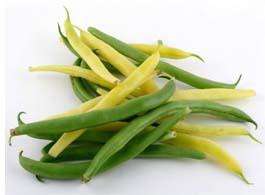MAINE-LY GARDENING: What’s in the garden? Beans

 by Jude Hsiang
by Jude Hsiang
Beans are so easy to grow. The littlest gardeners can plant them and see them come up quickly. There are so many varieties and ways to serve them that it’s no wonder that lots of gardeners grow several types: for eating freshly picked through the season; freezing or canning for winter; or storing as dry beans for soups and other favorite meals.
Beans can be planted as soon as danger of frost is over, or you can also start them inside to get a little jump on the season. It’s not too late to plant some now as beans only take two months or a bit more to mature. Planting a row every two to three weeks will ensure plenty for summer meals without overwhelming the gardener. When the production of the earliest plants begins to slow down, you can pull them out and replace them with other crops that will mature quickly, like radishes, lettuces, and greens.
Both bush or pole types have their merits. If you are short on space, pole beans will grow vertically on a trellis – you can rig one with sticks and string – and produce for a longer time. Bush beans take more space but tend to produce over a shorter time span.
Whether yellow or green, beans grown to be harvested fresh are sometimes called string beans or sometimes snap beans because when ripe they snap when bent. If they get away from you and begin to show bulging beans in the pods, you may not find them tasty, but you can let them dry on the plant and save them for soup in the future.
Reliable information on safely freezing or canning beans – and other garden produce – can be found through the University of Maine Cooperative Extension. Recipes, too.
There are so many varieties of beans that it can be hard to decide which to choose. The Extension makes suggestions for Maine gardens, and family members and friends may have favorites. In addition to your favorite ways of preparing beans, you may want to learn which varieties are particularly good for saving as seeds for the following year. Seed swaps and seed libraries are great ways to share extras and try new types at no cost.
You may want to add beans that are decorative as well as good tasting. Scarlet Runner beans with their bold red flowers are fun to grow on a trellis at the back of the garden or planted among flowering vines. Cherokee Trail of Tears beans – descended from beans saved by the Cherokee people who were forced off their land in 1838 – have lavender flowers and purplish pods. Like many purple vegetables, the pods will turn green when cooked, but they are still pretty plants. I grow them every year because I love the shiny black dried beans and save some seeds for next year.
Not as widely grown here as string beans are fava or broad beans. They can be planted much earlier than snap beans – as soon as the soil can be worked, like peas – and their sturdy stems produce side shoots that can be harvested for dinner while you wait for their pretty white flowers with black spots to produce big, thick pods. All parts of the plant make good eating, even the flowers.
The nutritional value of beans is well established. Our ancestors didn’t know that eating a meal that combines beans with rice, pasta, potatoes or other carbohydrates in combination gives us the proteins found in meats, but they knew the results were satisfying. Saturday night baked beans or festival bean hole beans are part of New England cultural tradition. Let’s grow beans!
© Judith Chute Hsiang
Jude Hsiang is a retired Extension Master Gardener instructor and member of the China Community Garden Committee.
Responsible journalism is hard work!
It is also expensive!
If you enjoy reading The Town Line and the good news we bring you each week, would you consider a donation to help us continue the work we’re doing?
The Town Line is a 501(c)(3) nonprofit private foundation, and all donations are tax deductible under the Internal Revenue Service code.
To help, please visit our online donation page or mail a check payable to The Town Line, PO Box 89, South China, ME 04358. Your contribution is appreciated!


Leave a Reply
Want to join the discussion?Feel free to contribute!